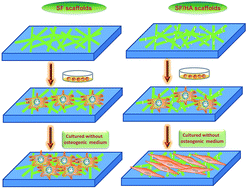Hydroxyapatite-containing silk fibroin nanofibrous scaffolds for tissue-engineered periosteum
Abstract
The periosteum plays an indispensable role in both bone formation and bone defect healing. The purpose of this study was to construct a functional periosteum in vitro. We developed a simple technology to generate a hydroxyapatite (HA)-containing silk fibroin nanofibrous scaffold as a potential substitute for periosteum. The chemical structural characteristics of the scaffold were evaluated and the results confirmed the presence of HA in the scaffolds. In addition, the Young's modulus of silk fibroin–hydroxyapatite (SF/HA) scaffolds increased with the increasing content of HA. Rat bone marrow derived mesenchymal stem cells (rBMSCs) were cultured on the scaffolds for 7, 14, and 21 days without adding any osteogenic factors. Cell proliferation assay and cell morphology observation indicated that 30% SF/HA scaffolds exhibited good cell attachment and proliferation. In addition, differentiation of rBMSCs into osteogenic lineage was more actively exhibited on 30% SF/HA scaffolds, as evident by real-time reverse transcriptase-polymerase chain reaction (RT-PCR) analysis for osteoblast-related gene markers (e.g., COL1A1, ALP, and Runx2), ALP activities, mineral deposits and immunocytochemical evaluations of osteoblast-related extracellular matrix components (e.g., OPN, ONN, and OCN). All the data in this study suggested that 30% SF/HA scaffolds had great potential as osteogenesis promoting scaffolds for constructing tissue-engineered periosteum.


 Please wait while we load your content...
Please wait while we load your content...